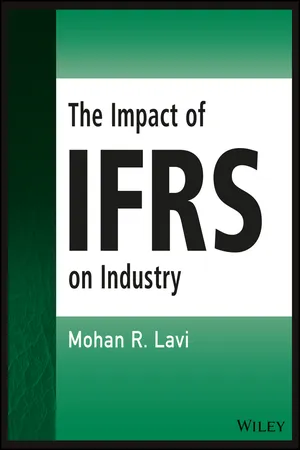
- English
- ePUB (mobile friendly)
- Available on iOS & Android
The Impact of IFRS on Industry
About this book
One of the biggest challenges of any reporting standard is how best to interpret and implement it in the context of a specific company or industry, given that each industry has its own intricacies and nuances. The Impact of IFRS on Industry provides specific guidance on applying IFRS in a diverse range of sectors.
Opening with an overview of IFRS, including a summary of all the standards, the book goes on to provide detailed coverage of the standards that can impact all industries, including IAS-40, IFRS 1, and IFRS 5. Thereafter, it offers practical advice and guidance on the application of IFRS in specific industries, including automotive; oil and gas; bio-sciences; infrastructure; airlines; media and communications; government-owned entities; mining; software; banking and financial services; insurance; FMCG; shipping; pharmaceuticals; telecoms; real estate and construction; power; SMEs; retail; e-commerce; and the service sector. The book concludes with a discussion on the collateral impact of implementing IFRS and how forthcoming IFRS Standards could impact specific industries.
Worked examples are used throughout to demonstrate how the standards are applied in practice.
- Understand the IFRS standards comprehensively
- Learn which standards impact all industries
- Examine the ways in which IFRS is applied in practice
- See how different standards are applied in specific industries
Suitable as a quick reference or a comprehensive guide, The Impact of IFRS on Industry gives you the real-world IFRS answers you need.
Frequently asked questions
- Essential is ideal for learners and professionals who enjoy exploring a wide range of subjects. Access the Essential Library with 800,000+ trusted titles and best-sellers across business, personal growth, and the humanities. Includes unlimited reading time and Standard Read Aloud voice.
- Complete: Perfect for advanced learners and researchers needing full, unrestricted access. Unlock 1.4M+ books across hundreds of subjects, including academic and specialized titles. The Complete Plan also includes advanced features like Premium Read Aloud and Research Assistant.
Please note we cannot support devices running on iOS 13 and Android 7 or earlier. Learn more about using the app.
Information
Chapter 1
Introduction: The Background and Evolution of IFRS, and a Discussion on Why IFRS Would Have an Impact on Industry
1.1 Rule-based vs. Principle-based Standards
1.2 The Norwalk Agreement
Memorandum of Understanding
THE NORWALK AGREEMENT
- undertake a short-term project aimed at removing a variety of individualdifferences between U.S. GAAP and International Financial ReportingStandards (IFRSs, which include International Accounting Standards, IASs);
- remove other differences between IFRSs and U.S. GAAP that will remain atJanuary 1, 2005, through coordination of their future work programs; that is,through the mutual undertaking of discrete, substantial projects which bothBoards would address concurrently;
- continue progress on the joint projects that they are currently undertaking; and,
- encourage their respective interpretative bodies to coordinate their activities.
| Topic | Industry |
| 905 | Agriculture |
| 908 | Airlines |
| 910 | Contractors |
| 915 | Development Stage En... |
Table of contents
- Cover
- Title Page
- Copyright
- Table of Contents
- Preface
- Acknowledgements
- Chapter 1: Introduction: The Background and Evolution of IFRS, and a Discussion on Why IFRS Would Have an Impact on Industry
- Chapter 2: Summary of Disclosures Under IFRS Standards
- Chapter 3: IFRS Standards that Could Impact All Industries
- Chapter 4: The Impact of IFRS Standards on Specific Industries
- Chapter 5: Forthcoming IFRS Standards That Could Impact Industry
- Chapter 6: Collateral Impact of a Transition to IFRS
- Afterword
- Appendix: Impact Summary
- Index
- End User License Agreement